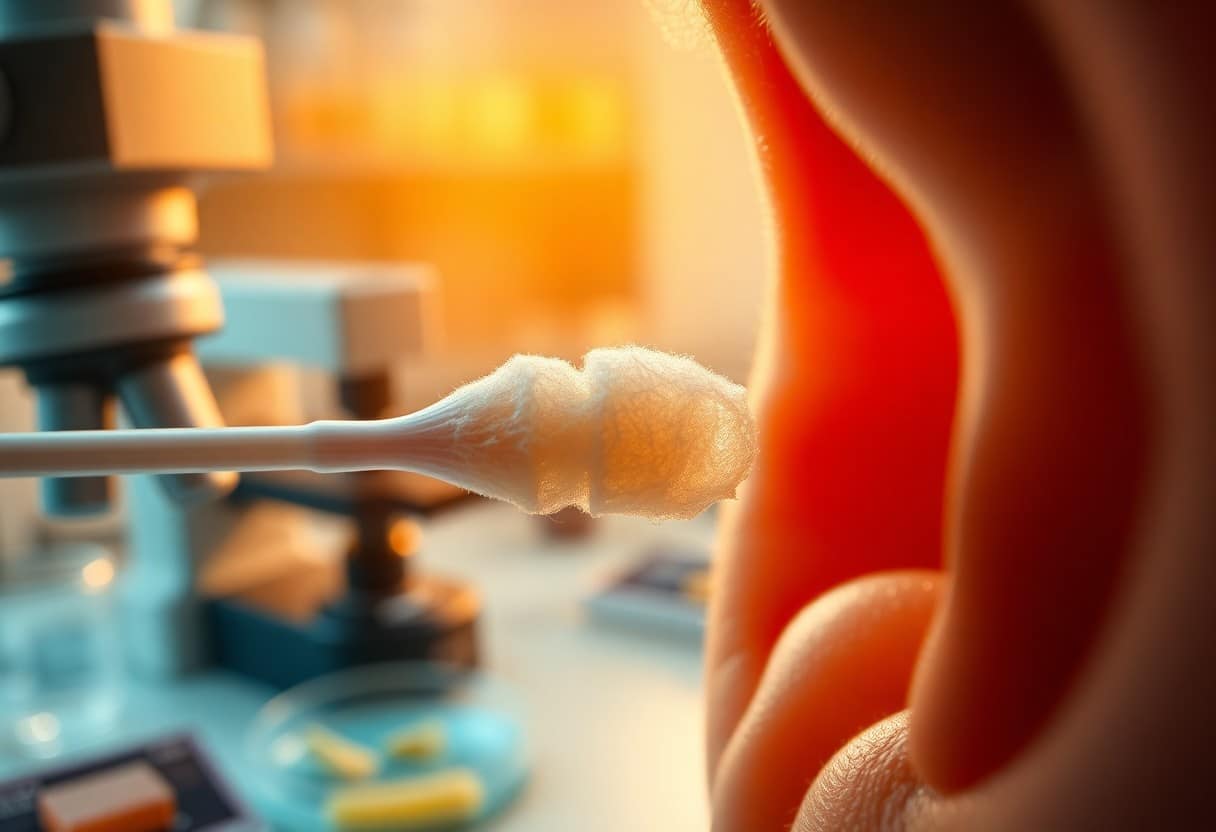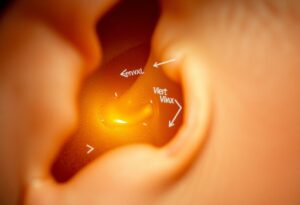Just as your skin produces oil to protect and moisturize, your ears produce cerumen, commonly known as earwax. This natural substance plays an necessary role in keeping your ears healthy by trapping dust, debris, and microorganisms, preventing them from reaching your eardrum. Understanding the purpose and composition of cerumen can help you appreciate its importance in maintaining your auditory health and why, despite its often-unpleasant reputation, earwax is vital for your well-being.
Key Takeaways:
- Cerumen, or earwax, is a natural substance produced by glands in the ear canal that helps protect against dust, debris, and microorganisms.
- It serves to lubricate the ear canal and assist in self-cleaning by trapping particles and facilitating their removal.
- The composition of cerumen can vary among individuals, affecting its color and consistency, which may impact ear health and hygiene.
The Biological Purpose of Cerumen
Protective Barrier Against Foreign Particles
Cerumen acts as a natural barrier, trapping dust, debris, and other foreign particles that enter your ear canal. This sticky substance prevents these unwanted elements from reaching the delicate structures of your inner ear, significantly reducing the risk of irritation or injury. By creating a physical barrier, earwax helps maintain ear health, filtering out harmful agents before they can cause discomfort or infection.
Antimicrobial Properties and Infection Prevention
Your earwax contains various antimicrobial agents, which play a vital role in keeping your ears healthy. These compounds inhibit the growth of bacteria, fungi, and other pathogens that could otherwise lead to infections. Studies have shown that cerumen’s unique composition aids in creating an inhospitable environment for harmful microorganisms, thereby significantly lowering the risk of ear infections.
The antimicrobial properties of cerumen are attributed to its fatty acids and lipids, which exhibit inherent antibacterial qualities. For instance, certain enzymes present in earwax can destroy the cell walls of bacteria, while its slightly acidic pH prevents fungal growth. This unique combination promotes a self-cleaning mechanism, allowing your ears to maintain health effectively without the need for excessive cleaning or intervention. The continuous production of earwax ensures that your ear canal remains an effective defense system against infections and other complications.
The Composition of Earwax: What’s in It?
The Roles of Lipids, Fatty Acids, and Cholesterol
Lipids, fatty acids, and cholesterol are key components of earwax, contributing significantly to its unique properties. These substances provide a hydrophobic barrier, which helps keep moisture out of your ear canal while trapping unwanted particles. Fatty acids possess antibacterial properties that further protect against infections, ensuring your ear health is maintained. Cholesterol aids in the consistency of earwax, making it neither too runny nor too solid, enabling it to perform its protective functions effectively.
The Influence of Genetics on Cerumen Composition
Your genetics play a significant role in determining the composition and consistency of your earwax. Studies have shown that genetic variations can lead to differences in earwax types, categorized broadly into wet and dry forms, influenced primarily by a single inherited allelic variation. This variation impacts the presence of specific proteins and lipids in your cerumen, affecting its texture and properties.
The Production and Lifespan of Earwax
How Cerumen Glands Work
Your earwax is produced by specialized glands called ceruminous glands located in the outer ear canal. These glands secrete a mixture of fatty acids, alcohols, and other substances that form cerumen. You have both apocrine and sebaceous glands that contribute to earwax production, combining moisture-rich secretions with oils to create waxy protection against bacteria and fungi. The glands function continuously, adjusting production based on your environment, health, and age.
The Natural Cycle of Earwax Production and Shedding
Cerumen follows a natural life cycle, typically moving from the inner ear canal to the outer ear, where it eventually flakes off or falls out. As you chew or talk, the motion of your jaw helps facilitate this movement. Generally, a new layer of earwax is produced every few weeks, ensuring your ears remain clean. This cycle is effective at maintaining ear hygiene without excessive buildup.
Your earwax production and shedding are influenced by factors such as individual metabolism and skin conditions. A healthy ear canal should see cerumen gradually migrate outwards, allowing you to maintain a balance without requiring frequent cleaning. In some instances, a person’s ears may produce excess wax or become too dry, leading to blockages that may necessitate medical intervention, showcasing the dynamic nature of earwax production in response to your overall health and lifestyle.
The Role of Cerumen in Hearing Health
Earwax and the Sensitivity of the Ear Canal
Your ear canal is sensitive and designed to detect sounds, while cerumen provides a necessary protective layer. It helps maintain the skin’s moisture, reducing the likelihood of irritation, itchiness, or even infections. This natural lubrication promotes a healthy ear environment, allowing your auditory system to function optimally without discomfort or obstructions.
The Impact of Cerumen on Auditory Function
Cerumen influences how well you can hear by maintaining the health of your ear canal. An appropriate amount of earwax helps facilitate sound transmission and prevents the ear from becoming overly dry or inflamed. However, an excess of cerumen can lead to blockages, impacting hearing clarity and causing potential discomfort.
Many individuals experience temporary hearing loss due to an abundance of earwax that builds up and obstructs sound waves from reaching the eardrum. This blockage may manifest as muffled hearing or a feeling of fullness in the ear. Studies indicate that over 60% of earwax impaction cases result in hearing difficulties, underscoring the importance of maintaining healthy cerumen levels for your audiological well-being. Regular check-ups can help ensure your earwax remains within a beneficial range, promoting optimal hearing health.
Myths and Misconceptions About Earwax
Debunking the “Dirty” Myth
The idea that earwax is simply dirty or unclean is a common misconception. In reality, cerumen plays an important role in protecting your ear canal from dust, debris, and microorganisms. This natural substance is actually a defense mechanism your body employs, keeping your ears healthy rather than being a sign of poor hygiene.
The Truth About Ear Cleaning Practices
Many believe that frequent ear cleaning is necessary for good hygiene, but this can actually be harmful. Inserting cotton swabs or other objects into your ears can push wax deeper, leading to blockages and potential damage to your ear canal. Your body has a natural way of managing earwax, and excessive cleaning can disrupt this balance.
Most people do not require routine ear cleaning, as the ear canal is self-cleaning. Your jaw movements, such as chewing, help push old cerumen out, where it can naturally flake away. In fact, the American Academy of Otolaryngology advises against the use of cotton swabs, emphasizing that earwax should only be removed if it causes hearing issues or discomfort. Understanding this helps you avoid potential complications linked to improper cleaning techniques.
When Earwax Becomes a Problem
Recognizing Symptoms of Excessive Cerumen
Excessive earwax can lead to symptoms such as ear pain, a feeling of fullness in the ear, decreased hearing, and even dizziness. You may also notice a ringing sensation in your ears, known as tinnitus, which can arise as a result of blockage. In some cases, excessive cerumen might trigger itchiness or discharge, signaling the need for attention.
Safe Removal and Professional Interventions
While you might be tempted to use cotton swabs for earwax removal, this can often push wax deeper into the ear canal and cause further blockages. You can try softening earwax at home with mineral oil or over-the-counter drops. If you experience persistent symptoms, a healthcare professional can safely remove earwax through methods like suction or irrigation, reducing the risk of damage.
Seeking professional help is especially advisable if you notice severe hearing loss or pain, as these can indicate a significant blockage. Healthcare providers typically have specialized tools designed for earwax removal, ensuring it’s done without injury to your ear canal or eardrum. Regular check-ups can also help prevent the build-up of excessive cerumen, allowing you to maintain optimal ear health efficiently.

Cultural Perspectives on Earwax
Historical Views and Rituals Surrounding Earwax
Throughout history, various cultures have held unique beliefs about earwax. In some ancient societies, earwax was considered a vital part of personal hygiene, while others viewed it as a sign of spiritual health. Certain rituals involved the ceremonial removal of earwax, believed to release negative energies. In Japan, for instance, specialized practices for earwax removal emerged, sometimes incorporating soothing techniques that symbolized care and community bonding.
Modern-Day Attitudes and Cerumen in Different Cultures
Contemporary views on cerumen vary significantly around the globe. In Western cultures, earwax is often associated with cleanliness and personal care, prompting individuals to use cotton swabs or other products to manage it. Conversely, some Indigenous cultures perceive earwax as a natural bodily substance, embracing its presence without concern for removal. Social media has also influenced perceptions, leading to a rise in ear cleaning trends that sometimes prioritize aesthetics over health implications.
In many cultures, earwax removal has transitioned from a necessity to an aesthetic choice. In the United States and parts of Europe, advertisements for various ear cleaning tools promote an obsession with ear hygiene. Meanwhile, cultures that emphasize holistic health often regard earwax as beneficial, understanding its role in protecting the ear. For instance, in certain Asian traditions, the act of ear cleaning is executed as a relaxing ritual rather than a hygienic obligation, showcasing how varied attitudes shape practices surrounding cerumen across the globe.

The Future of Earwax Science
Research Developments in Cerumen Study
Recent studies are exploring the molecular composition of cerumen, aiming to understand its antibacterial properties and potential role in preventing ear infections. Researchers have identified specific enzymes in earwax that may be responsible for its protective functions, offering insights into how it keeps the ear canal healthy. Advanced imaging techniques and genomic studies are providing a clearer picture of contributors to earwax variability among individuals.
Emerging Trends in Ear Health and Hygiene
Emerging trends highlight a shift towards preventative ear health and more holistic approaches to hygiene. Auditory health professionals now emphasize the importance of natural earwax as a protective barrier, advocating against over-cleaning with cotton swabs, which can push wax deeper. Innovative products like earwax softening oils and ear irrigation systems are gaining popularity, promoting safer methods to manage ear cleanliness without disrupting the ear’s natural processes.
Final Words
Taking this into account, understanding cerumen, or earwax, reveals its important role in your ear health. It serves as a protective barrier, trapping dust and debris while preventing infections. Your body produces this natural substance to maintain ear hygiene, ensuring the auditory system functions effectively. Regular cleaning of the outer ear is all that is needed to manage earwax build-up, but it’s vital to avoid inserting objects into your ear canal, as this can lead to blockages and irritation. Maintaining awareness of earwax’s purpose can help you care for your auditory health.
FAQ
Q: What is cerumen?
A: Cerumen, commonly known as earwax, is a natural substance produced by the sebaceous and ceruminous glands in the ear canal. It serves to lubricate, protect, and clean the ear by trapping dust, debris, and microorganisms.
Q: Why do we produce earwax?
A: The production of earwax is a normal biological process that helps maintain ear health. It creates a barrier against dirt and bacteria, preventing infections and promoting self-cleaning of the ear canal.
Q: Is earwax harmful?
A: Earwax is not harmful; in fact, it plays a beneficial role in ear health. However, excessive buildup can lead to blockages, discomfort, and potential hearing issues, requiring removal by a healthcare professional.
Q: How does earwax differ between individuals?
A: The consistency and amount of earwax can vary among individuals due to genetic factors, hygiene practices, and environmental influences. Some people produce drier earwax, while others may have a wetter consistency.
Q: How should earwax be cleaned?
A: Generally, earwax requires minimal intervention. Routine cleaning with a damp cloth around the outer ear is sufficient. For excessive buildup, consult a healthcare professional for safe removal methods.



